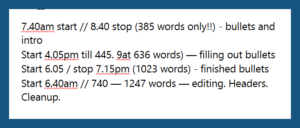Writing a good article can be a painful, time consuming and soul searching experience. Especially if you want to do it well.
We read thousands of words everyday and take it for granted how they were put together. We type bursts of instant messages that allow us to get away with disjointed sentence fragments that are casually glued together with emoticons and abbreviations.
But until you sit down to put together a long-form piece of content that needs to be coherent, easy to read, and be in line with modern day writing practices at the same time, do you realize how difficult it is to write something that looks and sound half decent.
For most of us anyway.
The Process of Writing an Article
I find it very useful to read about how other people do things. How they do it, how long they take, as well as their experience. Good and bad.
So I thought it would be useful to share the finer details of how I wrote an article recently about how to attract visitors to a website. For new bloggers and writers, this may be a handy reference or a rough framework to benchmark against. The stats were actually recorded for my personal time management, and to see how long each part of the process takes. The ultimate aim being to get an accurate log of time spent so that it can be compared to the costs of paying for freelance writing.
Another benefit of tracking the time spent writing (or wrestling with your thoughts) is that it stops you getting distracted by yet another all important tab (in your browser) that’s waiting to waste your time.

Calculating Price Per Word
Anyway, this 1223 word article I just wrote took a total of 3 hours and 50 mins to complete over 4 sessions. That comes out to 1223 / 230 mins, which is 5.3 words per minute or 319 words per hour. Comparing it to a writer than charges $50 per hour, gives us 50/319 or about 15 cents a word.
This may be high or low, depending on how you value your time, and the rates for freelance writers you’re comparing yourself to. For me, it’s extremely useful, as it gives a good perspective of why cheap 1-2 cents per word submissions are almost always disappointing, and how paying $70-100 or more for 1000 words of top-notch copy may have its place.
In this case, I’m familiar with the topic so no research needed to be done. If we include 30-60 mins for research, that could add another 20% to the time needed and bump up the cost.
Averagely Split over 4 Sessions
The breakdown for number of writing sessions and length per session varies for everyone, and for each article. I don’t have the luxury of sitting down for long sittings, so recording the time for each session is helpful to track progress, stay focused and keep it all together.
It’s interesting to see that the average sit down was about an hour, which makes sense. It usually takes at least 10 minutes to get going. And after an hour, the back needs a stretch, a coffee needs to be made, or the kids need their fix.
So, not quite the Pomodoro prescription for an ideal 25 minute system, but it works for me. I do feel that 20-25 minutes is a bit short, and maybe not so suitable for writing, where words don’t flow in a constant stream to be chunked into fixed time slots.
Time of Day
I would have expected the tranquility of early morning to produce the best writing. It certainly feels the most productive. So it is surprising to see that the performance during sunrise and sunset was comparable.
This may be due to a number of reasons so it’s probably best not to read too much into this one article’s data. Thinking time for outlining has different word count results to fleshing out bullet points, so it’s not quite apples for apples.
The bottom line is to do what works for you. Or maybe just to write when life permits, for those who aren’t in a position to fuss over when to write.
Non-Linear Writing Process
What’s most useful about this breakdown to me are the individual parts and the order in which they were done. This is what I’d be interested to see in other writers’ workflows.
While it may be possible to write linearly from start to end in one sitting, my approach appears to be more scatty. However, there is a certain formula of outlining, writing the intro, expanding bullets/sections, editing, refining headers and reading through to clean up.
What’s interesting is how each of the processes took roughly the same amount of time and were completed within each sitting. Possibly a coincidence.
For any non-fiction writers who are finding it tough to get articles written efficiently, it is definitely worth analyzing your process in detail to identify areas of friction.
What’s not Included
To be clear, everything shared so far has only been for the text content written. It doesn’t include formatting, adding links and so on.
Getting an article ready to be published online is normally relatively quick, but it can be quite a time sucker if you get engrossed selecting photos or creating custom images to complement the text.
I’ll probably end up rewriting the title (and possibly the sub-headings) a few more times and tweaking a bit more after a final read through.
Every Article is Different
To stay true to this post about blog writing time management and tracking the process of creating an article, it was only fitting to note how long this one took to write too.
Surprisingly, up to this point, its 1008 words has been done in one sitting and it’s only coming up to 2 hours. Once again, this is fast because research wasn’t needed and I’m comfortable with the topic.
In fact, it’s just writing about writing, and it was approached in an open way to share a real life experience, so it had foundations to make it easier to write.
Do share any comments or questions below. How do you approach a blank canvas? Do you have any creative writing tips and techniques that have been polished over years as a text wrangler?










